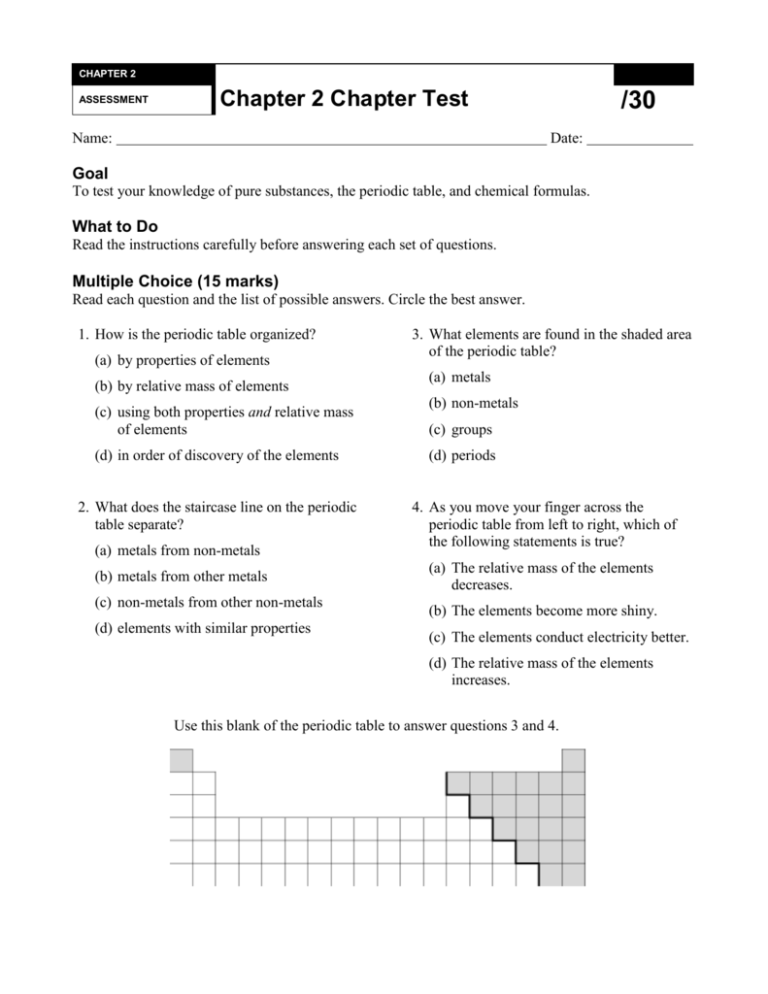CHAPTER 2 Test
advertisement

CHAPTER 2 ASSESSMENT Chapter 2 Chapter Test Name: /30 Date: Goal To test your knowledge of pure substances, the periodic table, and chemical formulas. What to Do Read the instructions carefully before answering each set of questions. Multiple Choice (15 marks) Read each question and the list of possible answers. Circle the best answer. 1. How is the periodic table organized? (a) by properties of elements (b) by relative mass of elements (c) using both properties and relative mass of elements (d) in order of discovery of the elements 2. What does the staircase line on the periodic table separate? (a) metals from non-metals (b) metals from other metals (c) non-metals from other non-metals (d) elements with similar properties 3. What elements are found in the shaded area of the periodic table? (a) metals (b) non-metals (c) groups (d) periods 4. As you move your finger across the periodic table from left to right, which of the following statements is true? (a) The relative mass of the elements decreases. (b) The elements become more shiny. (c) The elements conduct electricity better. (d) The relative mass of the elements increases. Use this blank of the periodic table to answer questions 3 and 4. CHAPTER 2 ASSESSMENT BLM 2–9 Chapter 2 Chapter Test (continued) 5. Which of the following properties does not describe a metallic element? (a) reflects light easily (b) poor conductor of heat and electricity (c) easily shaped (d) probably solid 6. Which of the following statements properly describes the periodic table? (a) Elements are organized in alphabetical order. (b) The rows are called groups. (c) The rows are called periods. (d) Elements are organized in order of discovery. 9. Which statement is true of a chemical formula? (a) uses subscript numbers to indicate number of compounds in the substance (b) indicates the chemical properties of the substance (c) describes the physical properties of the substance (d) uses subscript numbers to indicate the ratio of elements in a substance 10. How many elements are found in monosodium glutamate, which has this formula: NaC5H8NO4(s)? (a) 5 (b) 17 (c) 19 7. A pure substance is made up of only one type of particle. Which of the following items lists pure substances? (a) elements only (b) compounds and mixtures (d) 4 11. How many atoms are found in a single particle of monosodium glutamate, which has this formula: NaC5H8NO4(s)? (c) all matter (a) 5 (d) compounds and elements (b) 17 (c) 19 8. What does a decomposition reaction do? (a) combines elements to form a new substance (b) breaks an element into simpler substances (c) breaks a compound into simpler substances (d) turns a nickel into gold (d) 4 CHAPTER 2 ASSESSMENT BLM 2–9 Chapter 2 Chapter Test (continued) 12. Which of the following best describes a decomposition reaction? (a) Chemical energy is used to produce electrical energy. 14. Many household products have scientific names. Which of the following pair of common name and scientific name is correct? (b) Electrical energy is used to break a compound apart. (a) baking soda, sodium bicarbonate (c) A more complex substance is formed. (c) vinegar, hydrochloric acid (d) Compounds form from elements. (d) vinegar, sodium chloride 13. What elements can be trapped by decomposing water? (b) baking soda, hydrogen bicarbonate 15. Which of the following pair of terms is incorrect? (a) air and water vapour (a) non-metal, shiny (b) oxygen and hydrogen (b) element symbol, one or two letters (c) helium and oxygen (c) compounds, can be broken into simpler substances (d) hydrogen and osmium (d) element, cannot be divided easily Short Answer (15 marks) Read each question carefully. Write your answer in the space provided. Answers in point form are permitted. 16. Describe two ways the periodic table is organized. (2 marks) 17. Scientists have used decomposition reactions to see if a substance could be broken down into simpler substances. Discuss how scientists could use this process to see if a substance was a compound or an element. (2 marks) Copyright © McGraw-Hill Ryerson Limited. Permission to reproduce this page is granted to the purchaser for use in her/his classroom only. CHAPTER 2 ASSESSMENT BLM 2–9 Chapter 2 Chapter Test (continued) 18. Compare metallic and non-metallic elements by completing this chart. List at least two similarities and at least two differences. (4 marks) Differences Metals Non-metals Similarities 19. (a) How many different elements are found in acetaminophen, C9H9NO2(s)? (1 mark) ______ 20. Why is it important for scientists everywhere around the world to use standard symbols for the elements? (1 mark) (b) How many atoms are found in a single particle of acetaminophen? Show your work. (1 mark) 21. Chemicals play a major role in our everyday lives. Think about two chemicals that are important to you and describe the role of each. (2 marks) __________________________________________________________________________________ __________________________________________________________________________________ __________________________________________________________________________________ 22. You are given a sample of an unknown element. Describe two tests you would use to determine whether this element is a metal or a non-metal. (2 marks) _______________________________________________________________________________ _______________________________________________________________________________ _______________________________________________________________________________ _______________________________________________________________________________ Copyright © McGraw-Hill Ryerson Limited. Permission to reproduce this page is granted to the purchaser for use in her/his classroom only.











